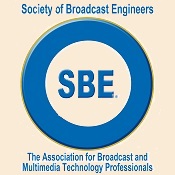
|

CHAPTER 24, Inc., MADISON, WI
|
|
Monthly eNews
|
November 2021
|
Our Next Meeting:
Thursday, November 18th
AoIP and Remote Mixing
by Rob Lewis of Calrec
How can I mix remotely was a question heard regularly since March of 2020. Calrec has several ways to achieve this depending on your broadcast requirements, infrastructure and how remote you need to be. Rob Lewis, US Technical Sales Manager, will walk us through several example workflows of how to achieve this.
7:00 PM - Meeting/Program
This meeting is Virtual
Connection information will be distributed
in the days just prior to the meeting.
Last Meeting's Minutes
Submitted by Mike Travis, Secretary
The SBE Chapter 24 meeting was called to order by Matt Mommaerts at 07:01pm, October 27th, 2021 via Zoom.
Approval of Minutes
Michael Travis made a motion to approve the secretary meeting minutes from 9/09/2021, seconded by Matt Mommaerts and approved as submitted.
Treasurer's Report
Mike Norton, as Chapter Treasurer, states there were no financial transactions since the last meeting/report. The Chapter 24 checking account balance remains [well into the black].
Chapter Newsletter
The deadline for articles for the November eNews letter is Monday November 1st at 5pm. Please forward any article of interest to Chapter members to Lcharles@sbe.org.
Membership Report
For the membership report, Matt Mommaerts reports there are no changes to our existing membership. We stand at 48 official members that National SBE has assigned to Chapter 24.
Sustaining Member Chair
Fred Sperry was unavailable but Matt Mommaerts reports we have no new sustaining members.
Program Committee
Matt Mommaerts, as head of the program committee, reports we have programs for the rest of the year.
Certification and Education
With certifications and education, Jim Hermanson reports the 2022 exam schedule is now open. The next exam session is February 4th - 14th, 2022. January 3rd, 2022 is the deadline to sign-up for that exam session.
Frequency Coordination
Tom Smith, with frequency coordination, reported we have coordination for audio for all the Fox games. Nothing for BTN. We had one airplane feed for aerial shots at Camp Randall.
SBE National News
With the cancellation of the NAB Show and the in-person SBE National Meeting, the SBE Membership Meeting and Awards Program was presented online. It was streamed on October 18 as the October SBE WEBxtra. The replay of the event is available on the SBE YouTube Channel.
Also because of the NAB Show cancellation, the SBE Board of Directors meeting was moved to Oct. 11 and was held virtually. One piece of business was updates to the SBE By-laws, particularly to the method to update the by-laws and disseminate the changes to members, taking into account more modern forms of communication. Full details will be included in the December issue of The Signal, and will be posted to the SBE website.
Matt Mommaerts reports we were recipients of two awards from the National SBE. One for Best Regional Education Event (Broadcasters Clinic) and one for the Most Certified Chapter. Matt will send out a picture of the awards later this week.
The Wisconsin Broadcasters Association provided the audio and presentation files from the Wisconsin Broadcasters Clinic. Visit www.sbe24.org/WBA-SBE-Shows/Archives/Clinic2021/21dex.asp.
Adjournment
Leonard Charles made a motion to adjourn, seconded by Mike Norton. Meeting adjourned at 7:12pm.
Presentation
The meeting was followed by a presentation on "Evolution of Industrial Batteries:
Lithium for the Broadcast Market" by Chris Cleary and Chuck Barry from Staco Energy Products. Thank you Chris and Chuck! Check out Staco Energy Products at www.stacoenergy.com.
Job Opening: PBS Wisconsion
Broadcast Sound Engineer
Click Here
(November 22nd application deadline)
Job Opening: WKOW TV
Part Time Master Control Operator
For information Click Here
Search for a new Sustaining Membership Chair
Coming Down to the Wire!
Your current Sustaining Membership Chair is retiring at the end of the year and after 25 years in the position is looking for another Chapter member to take over the post. The workload for this position is minimal only requiring minutes of your time each month and is a great way to be involved in Chapter 24. Tasks involve sending out renewal notices to existing sustaining members of Chapter 24, sending application materials to prospective sustaining members, forwarding the received payments to the Chapter 24 Treasurer and providing announcements of new members and renewals at chapter meetings. All the necessary paperwork to do these tasks have already been created.
If you are interested in taking over this position, please contact Chapter Chair Matt Mommaerts or current Sustaining Membership Chair Fred Sperry.
Thank you for your consideration!
Program Ideas Appreciated
The Chapter 24 meeting schedule is available here. While our 2021 schedule is full our 2022 calendar is wide open. Is there a topic you would like to see covered at one of our local Chapter 24 meetings? Or, better yet, is there a topic that you'd like to speak about at an upcoming meeting? Please forward any ideas to Matt Mommaerts or to one of the Chapter 24 officers for consideration.
Amateur Radio News
Compiled by Tom Weeden, WJ9H
Students at UK School for Deaf Youngsters Enjoy Space Chat
As previewed last month, ten students at the Mary Hare School for deaf children in the UK took part in what appears to have been a world-first event for Amateur Radio on the International Space Station (ARISS). Facilitating the late-morning direct contact with astronaut Mark Vande Hei, KG5GNP, at NA1SS were ARISS-UK volunteers and members of the Newbury and District Amateur Radio Society (NADARS).
The ground station used the call sign GB4MHN. ARISS-UK volunteers handled the technical aspects, while NADARS members provided students with the "amateur radio experience" through events and activities.
Students asked their questions orally, and the astronaut's replies -- as well as questions and answers posed by the audience before the contact began -- were displayed in closed caption format beneath a huge video screen.
The Mary Hare School is an aural school for the deaf that teaches students to develop lip-reading skills and to make use of technology. Students range in age from 5 through 19 years old. An enthusiastic audience of some 250 individuals was in the auditorium, where the contact took place, while another 600 students at other locations in the school observed the contact via a web feed.
Leading up to the contact, students at the school learned about radio- and space-related topics that touched on physics, chemistry, and biology. Student activities have included designing and flying model rockets, making astronomical observations, and observing authentic spacesuits.
Students wanted to know if the astronauts used sign language in space in case something goes wrong, how the ISS would be evacuated in the event of a fire, and whether mobile devices such as cell phones work in space.
Thanks to ARISS, amateur radio equipment has been on board the ISS for more than 20 years, and most astronauts hold ham radio licenses.
A livestream of the event has been archived. www.youtube.com/watch?v=wmI3qKZgjJ4 (Contact begins at about 48:40)
ARRL Continues Its Efforts to Preserve Amateur Radio Secondary Use of the 3 GHz Band
ARRL President Rick Roderick, K5UR, in a written statement on the newly filed H.R.5378 before the US House Commerce Communications and Technology Subcommittee, urged Congress to direct the FCC to preserve amateur radio's secondary use of the 3-GHz band. President Roderick's statement was the result of a quick, well-organized response by ARRL to counter the continuing threat to amateur radio's secondary use of the 3 GHz band.
ARRL became aware of a provision in the $3.5 Billion Budget Reconciliation Bill that would have required that approximately 200 MHz of the 3.1 - 3.45-GHz band be reallocated to the use of 5G vendors. Moving swiftly, the ARRL Executive Committee authorized ARRL's Washington Counsel to begin preparations to respond. But, confronted with the probable delay of the Reconciliation Bill and an uncertain future for the 3 GHz provisions, Subcommittee Chairman Michael Doyle (D-PA-18) and Representative Doris Matsui (D-CA-6) introduced similar reallocation language on September 29 as H.R.5378.
In his written statement to the Subcommittee in conjunction with the hearing, President Roderick emphasized that permitting Amateur Radio to continue to have use of the 3.3 - 3.45-GHz band on a strictly secondary, non-interfering basis will provide full protection to commercial licensees with exclusive licenses and further the public interest in providing a means for continued technological innovation. He said there is no technical basis for removing amateur secondary operations from the 3 GHz band where radio amateurs "long have used the bits and pieces of unused spectrum for technological innovation."
(Excerpts from the American Radio Relay League's arrl.org web site)
FCC NEWS
compiled by Tom Smith
TV Allocation Rules Updated
The only action that the FCC scheduled for its October meeting was an updating of the rules for the allocation of TV channels. The action (FCC-21-111A1) was then removed from the meeting agenda for the October meeting as it was adopted before the meeting on October 22nd. The FCC takes action on many rulemakings by coming to a consensus between the Commissioners before the meeting and removing it from the meeting agenda.
The rulemaking did three things concerning the allocation of TV channels. The first part of the rulemaking made the reduction of the TV band from the post DTV transition band of channels 2 through 51 to post incentive auction channels 2 through 36. The notice listed the post auction channels and their frequency allocations and changed all mentions of the TV band from channel 2-51 or in some cases the pre 2009 post analog to DTV transition channels 2-69 mentions. For some low-power and translator stations that have not been displaced by new wireless operations, the rules changed the channel notations from channels 2-69 to channel 2-51. The second change in the new rules removed sections of the rules pertaining to analog operation. The FCC required the last analog operations to cease this last July for LPTV and translator stations. The rule changes included the deleting of rules pertaining to power limits for analog LPTV and translator radiated power limits, interference between DTV and analog stations and protection to land mobile from stations operating on channel 69 as they no longer need to be protected from the non-existent channel 69 TV stations. The final change is the updating of the table of allocations to the post 2018 incentive auction allocations. Besides listing the RF channels in each city, the FCC lists a channel S for each station that gave up its RF channel and retained its license by agreeing to share a channel with another station. The new list of allocations differs from the old analog table in that communities that previously had allocations for an analog station that went unused, but were not given replacements in the new table. Anyone desiring to place a new station in any community will have to petition for a new TV channel allocation. The FCC opened the new TV band to petitions for new allocations in November of 2020. Finally, there was a section of the rules that was modified, but not removed concerning bandwidth restrictions for analog operation which seems odd since analog operation is no longer allowed for any full power, LPTV or translator TV station.
FCC Seeks To Minimize Service Disruptions
The FCC adopted a Notice of Rulemaking (FCC-21-99A1) on September 30th, releasing it on October 1st, seeking information on minimizing service disruptions during disasters. The notice mainly refers to communication services such as cell phone service and broadband and cable service. They are asking for information on maintaining power to and interconnection between cell towers including the ability to have cell phones use roaming between carriers to provide service. The notice suggests rules requiring back-up power for cell towers and mandatory reporting of outages during periods of disasters. After Hurricane Katrina, the FCC started the Disaster Information Reporting System and the Network Operation Reporting System for communication providers to report outages in a disaster area to the FCC. The reporting systems are voluntary and include radio and TV broadcasters. After hurricanes Sandy on the Northeast and Maria in Puerto Rico, the wind storms that swept across Iowa and recently Hurricane Ida brought renewed focus to service disruptions. Besides improving the reliability of the communication system with improved infrastructure, the FCC would like better outage reporting to better understand ways to further improve the communication system during disasters. Radio and TV broadcasters were briefly mentioned in the notice without being included in the overall proposals, but still could be included in the mandatory reporting and some stations could be subject to back-up power requirements to maintain EAS alerts to the public.
For the Record
(Wisconsin FCC Actions Granted)
compiled by Leonard Charles
from the FCC Daily Digest
10/06/2021
Licensee: Good Karma Broadcasting, LLC
WGKB, 1510 Khz, Waukesha, WI
Action: License to cover
|
10/14/2021
Licensee: Metro North Communications, Inc.
WLAK, 1520 Khz, New Holstein, WI
Action: Minor change in licensed facilities
|
Certification and Education
compiled by Jim Hermanson
Congratulations to Vicki Way Kipp and Dennis Baldridge for having their SBE ATSC3 certification achievements and experiences published in the ATSC news! The article can be read here... SBE Charts Success with ATSC3 Specialist Certification - ATSC : NextGen TV
The Open 2022 Exam Schedule
| Exam Dates |
Location |
Application Deadline
(to SBE National Office) |
February 4-14, 2022
|
Local Chapters (Madison Area)
|
January 3, 2022
|
June 3-13, 2022
|
Local Chapters (Madison Area)
|
April 15, 2022
|
August 5-15, 2022
|
Local Chapters (Madison Area)
|
June 10, 2022
|
November 4-14, 2022
|
Local Chapters (Madison Area)
|
September 9, 2022
|
Each year, account balance permitting, Chapter 24 will reimburse half the application fee to any member of Chapter 24 in good standing who successfully obtains any SBE certification level not previously held by that member. Contact the SBE Chapter 24 chairperson or certification chairperson for more information.
When you are ready to take an SBE exam, note the open exam schedule, complete the appropriate application (found here... http://www.sbe.org/applications) and send it directly to the SBE National office (see address below) with the respective fee. You will be notified once your application is approved. Your local certification chairman will receive a list of applicants and exams in his/her chapter and arrange for a proctor. He/she will then contact applicants to schedule a mutually agreeable date, time, and place for the exam(s) within the respective exam date window. This must be coordinated before the exam will be sent by SBE National. Completed exam(s) will be mailed back to SBE National for grading. Pass/fail results will be mailed directly to the applicants within approximately six weeks.
The majority of SBE certifications are open book and access to the Internet is allowed to give a more "real world" situation.
You may mail, email or fax your applications to:
Megan E. Clappe
Certification Director
9102 N. Meridian St.
Suite 150
Indianapolis, IN 46260
317-846-9120 Fax
mclappe@sbe.org
|
To apply for a specialist certification, an individual must currently hold certification on the Broadcast Engineer, Senior Broadcast Engineer, Professional Broadcast Engineer or Broadcast Networking Engineer Certification level. Exams must be completed within three hours and consist of 50 multiple-choice questions (two points each) and one essay question (20 points maximum). Examinees are provided one essay question to answer. Exams are pass/fail, and a score of 84 is a passing grade.
SBE Certified Logo
If you hold a valid SBE Certification, you are authorized to display the SBE Certified logo on your business cards, letterhead, resume, website and email signature. For the proper use of this logo and to download please visit the Press Logo page.
November Webinars
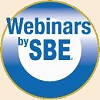
Use of Drones for Broadcast Signal Measurements
November 4, 2021 | 1 p.m. CT
In some instances, the use of drones for broadcast signal measurement can be misunderstood or not fully utilized.
This presentation will educate you about the use of drones and the exceptional benefits drones bring to understanding RF signals. Different types of drones will be covered and the pros and cons of each will be provided. The scopes of work available to the broadcast industry will also be discussed along with why the services should be used.
Other topics to be covered include interpolated data versus non-interpolated data and why the difference is noteworthy. The presentation will review insurance requirements, FAA licenses and the importance of flight logs, pricing and other supporting services including reporting structures and their immediate value to engineers and general managers.
Your Instructor
Phil Larsen, Vice President, Airborne Division QForce
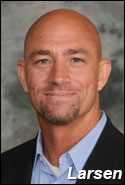
Phil brings exceptional industry experience in the combining of Unmanned Aerial Vehicles (UAV's) into the Broadcast / Telecommunication industries and is a proven business leader. He is considered one of the foremost experts in these industries and consults all over the world. Phil has worked for DoD, NSA, CIA, Navy and other governmental agencies in multiple capacities and most recently consulted numerous country and military leaders on strategic applications in internal security measures via UAVs. Phil holds three professional licenses, Firefighter, Emergency Medical Technician (EMT) and FAA 107 pilot and is a retired Rescue Chief.
SBE Recertification Credit
The completion of a Webinar from Webinars by SBE qualifies for 1 credit, identified under Category I of the Recertification Schedule for SBE Certifications.
Registration and Pricing
This webinar will be approximately 90 minutes long.
SBE Members: $62
MemberPlus Members FREE
Non-Members: $92
Register Here
Questions?
If you have questions regarding this course, contact Cathy Orosz via email or by phone at 317-846-9000.

SIP Series, Module 3: Case Study: Installing
and Operating a Broadcast Talk Show System in the Cloud
November 18, 2021 | 1 p.m. CT
Module 3 of the SIP series provides an end-to-end look at the process of installing, operating, and maintaining a broadcast talk show system in the cloud. We will explore the benefits uncovered and challenges encountered in the implementation process, point out some tips and tricks, evaluate the reliability and redundancy opportunities, and discuss the financial implications of this cloud-based operation.
This presentation will be useful for broadcast technologists who are interested in gaining a better nuts-and-bolts understanding of cloud operation. It will focus on practical implementation details and aims to interest those broadcast technologists with little to no cloud computing management experience. The material does assume a basic level of familiarity with VoIP within the context of broadcast systems, which was provided in Module 1 of this series.
Your Instructors
Shaun Dolan, Partner, Inrush Broadcast Services
Mike Dorris, Partner, Inrush Broadcast Services
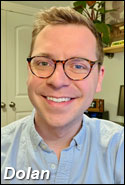
Shaun is a partner at Inrush Broadcast Services, a technology integration firm. He focuses on delivering the benefits of virtualized architectures while incorporating tried-and-true broadcast technology. His team provides turnkey project management, solutions consulting, and outsourced engineering support to respected media creators across the US. Previously, Shaun was a product manager at Telos Alliance, where his team developed a new virtualized broadcast talk show system and managed the VoIP product line.
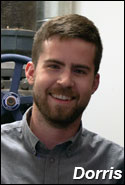
For more than a decade, Mike has enabled content creators to tell their stories and reach their audiences. He has led major studio and transmission rebuild projects for iHeartMedia, Audacy, Univision, Spanish Broadcasting System, Northeastern Public Radio, and others in markets from Los Angeles, to Seattle, to Gainesville, FL. Mike loves to break complex projects and timelines into their parts and make actionable plans to complete them. His straightforward style leaves Inrush clients feeling confident that he will get the job done. Currently he focuses on managing large-scale national projects at Inrush.
SBE Recertification Credit
The completion of a Webinar from Webinars by SBE qualifies for 1 credit, identified under Category I of the Recertification Schedule for SBE Certifications.
Registration and Pricing
This webinar will be approximately 90 minutes long.
SBE Members: $62
MemberPlus Members FREE
Non-Members: $92
Register Here
Questions?
If you have questions regarding this course, contact Cathy Orosz via email or by phone at 317-846-9000.
More information about registering using the SBE MemberPlus benefit
All SBE webinars are included at no additional cost for members who renew or join using the $175 SBE Member Plus membership option. Through this option you get access to all SBE webinars for no extra cost. Members can renew and newcomers may join online at the SBE website using the SBE MemberPlus option.
Access to the SBE webinars through the SBE MemberPlus program is limited to the MemberPlus-purchaser only. You are not permitted to distribute, sell, copy, share, project or otherwise make the webinars available to any other individual or group without express written permission by the SBE.
Several state-of-the-art radio, TV, multimedia, and IT engineering training is available through this page...
http://sbe.org/education/webinars-by-sbe/on-demand-webinars/
More information on SBE Education Programs is available here...
http://www.sbe.org/education/
Views expressed herein do not necessarily reflect the official position of the Society of Broadcast Engineers (SBE), its officers, or its members. SBE Chapter 24, Inc. regrets, but is not liable for, any omissions or errors. Articles of interest to Chapter 24 members are accepted up to the close of business the 1st day of each month. Send your article to lcharles@sbe.org.
|






